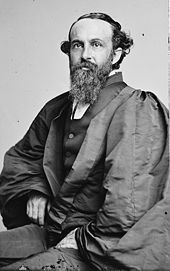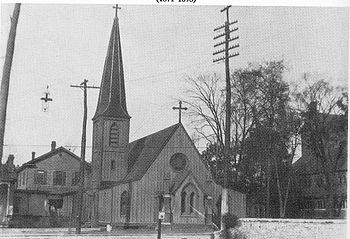- Charles Todd Quintard
-
 Mathew Brady portrait of "Rev. C.T. Quintard" sometime between 1855 and 1865.
Mathew Brady portrait of "Rev. C.T. Quintard" sometime between 1855 and 1865.
Charles Todd Quintard (1824–1898) was an American physician and clergyman who became the second bishop of the Episcopal Diocese of Tennessee and the first Vice-Chancellor of the University of the South at Sewanee.
Contents
Medical career
He was born in Stamford, Connecticut to a Huguenot-descended family and attended school in New York City, including medical studies at University Medical College, New York University and Bellevue Hospital, graduating in 1847. Quintard moved to Athens, Georgia, in 1848 to take up a medical practice, then moved to Memphis in 1851 to teach physiology and pathological anatomy at Memphis Medical College. Dr. Quintard's 1854 report on Memphis mortality statistics was covered in the New York Times, including his assessment of the city as being "the first considerable place to be without the range of yellow fever,"[1] a boast that proved tragically incorrect in the 1870s.
Priesthood
During this time, Quintard became friends with James Hervey Otey, the first bishop of the Episcopal Diocese of Tennessee, resulting in his decision to give up the medical profession for the priesthood. Quintard studied for holy orders in 1854, was ordained in 1856, and subsequently served as the rector of Calvary Church in Memphis and at the Church of the Advent in Nashville.
A supporter of the Oxford Movement he described himself as a "high churchman" and a "ritualist", identifying with Anglicans who were reviving ritual practices associated, in the popular mind, with Roman Catholicism.[2]
Civil War
After the outbreak of the American Civil War, Quintard was nominated by soldiers in the Confederate 1st Regiment Tennessee Volunteer Infantry, to serve as their chaplain. He accepted this invitation, despite his initial pro-Union stance, and also served as a regimental surgeon.[3]
 Bishop Quintard, wearing the cross of the English Order of the Hospital of St. John of Jerusalem, which he served as a chaplain for 25 years.[4]
Bishop Quintard, wearing the cross of the English Order of the Hospital of St. John of Jerusalem, which he served as a chaplain for 25 years.[4]
The South's first post-war bishop
Bishop Otey died in 1863, but the Diocese of Tennessee was unable to elect a new leader until after the war, on September 7, 1865, when it selected Quintard as its second bishop. The bishops and lay leaders of the national Episcopal Church confirmed his election the next month at the General Convention in Philadelphia. The subsequent consecration of the South's first post-war bishop was viewed as a sign of healing within the church, as evidenced by this comment in the October 13, 1865 New York Times:
- The entire service was one to be long remembered by all who witnessed it, and the occasion was one fraught with interest and importance in the history of the Church, as it marked the first step toward that reunion in the Church consequent upon the rapid march of events and the peace which now happily blesses our whole land. It is to be hoped that the occasion will strengthen that harmony which prevails in the convention, and be productive of beneficial results. [5]
Quintard received honorary doctorates from Columbia College (Doctor of Divinity, 1866) and Cambridge (Doctor of Laws, 1867).[6]
Stewardship of Sewanee: The University of the South
Quintard quickly launched rebuilding efforts in his diocese, which had suffered much physical and emotional distress during the war. He also led efforts to ensure the post-war survival of the fledgling University of the South at Sewanee, Tennessee. As the school's vice-chancellor (the institution's chief executive position, despite the name) Quintard sponsored the establishment of a training school for clergy there in 1866 and laid the cornerstone for St. Augustine's Chapel in 1867. He traveled to northern U.S. dioceses to raise funds for the university and went to England three times with the same purpose, returning with large sums of money and many books for the school's library.[7]
Cathedral
 The original St. Mary's Cathedral building, Memphis.
The original St. Mary's Cathedral building, Memphis.
At the beginning of 1871, Quintard was presented with the first Episcopal cathedral in the South[8], when the parish church of St. Mary in Memphis symbolically presented him with keys to the building. While the bishop retained his ecclesiastical seat in Memphis, he continued to live in Sewanee with his family. He ceded the "Bishop's House" on the close of St. Mary's Cathedral to the sisters of the Community of St. Mary for their educational and humanitarian missions.[9]
Quintard believed that his mission was to make the Episcopal Church in Tennessee “a refuge for all—the lame, halt and blind as well as the rich.” He opposed parish pew rents and fostered a ministry on behalf of the disadvantaged. Concerned by the effects of industrialization on workers, he established a refuge for the poor in Memphis in 1869, and in 1873 he advocated a plan to assist people lacking food, housing, and education. Quintard started missions for the laborers at foundries in South Pittsburg (1876) and in Chattanooga (1880). Hoping that the Episcopal Church would also expand its evangelistic work among African Americans, he opposed plans to segregate the black congregations of the denomination, and he assisted in the founding of Hoffman Hall, a seminary for African Americans adjacent to Fisk University in Nashville.[10]
Quintard died in February 1898 in Meridian, Georgia, while staying there in an effort to improve his health. Quintard is honored with a feast day on the liturgical of the Episcopal Church in the United States of America on February 16.
See also
- St. Mary's Episcopal Cathedral in Memphis
- Episcopal Diocese of Tennessee
- Sewanee: The University of the South
References
- ^ "Medical" New York Times, April 1, 1854.
- ^ The History of the Church in the Diocese of Tennessee. Arthur Howard Noll (1900, James Pott & Co.)
- ^ Doctor Quintard, Chaplain and Second Bishop of Tennessee: Being His Story of the War, 1861-1865 (1905) by Charles Todd Quintard, edited by Arthur Howard Noll, The University Press of Sewanee, Tennessee.
- ^ Heraldry in America, Eugene Zieber, Bailey, Banks & Biddle Company, 1900
- ^ http://query.nytimes.com/gst/abstract.html?res=F00E14F8385C1B7B93C1A8178BD95F418684F9 retrieved 10 April 2011.
- ^ Obituary, New York Times, February 16, 1898
- ^ Encyclopedia of religion in the South (2005), Charles Reagan Wilson. Mercer University Press.
- ^ http://www.episcopalarchives.org/cgi-bin/ENS/ENSpress_release.pl?pr_number=2000-137 See second-to-last paragraph
- ^ St. Mary's Cathedral 1858-1958, John H. Davis [1958], published by the Chapter of St. Mary's Cathedral (Gailor Memorial), Memphis, Tennessee.
- ^ The Episcopalians, David Hein and Gardiner H. Shattuck Jr. (2004, Praeger Publishers)
External links
- Documents by and about Quintard at Project Canterbury
- Address by the Rt. Rev. Thomas Frank Gailor about Bishop Quintard and the University of the South
- Charles Todd Quintard in the Tennessee Encyclopedia of History and Culture
Categories:- 1824 births
- 1898 deaths
- People from Memphis, Tennessee
- Sewanee: The University of the South
- American university and college presidents
- Anglican saints
- Bishops of the Episcopal Church in the United States of America
- 19th-century Anglican bishops
- 19th-century American Episcopalians
- Anglican bishop stubs
Wikimedia Foundation. 2010.
